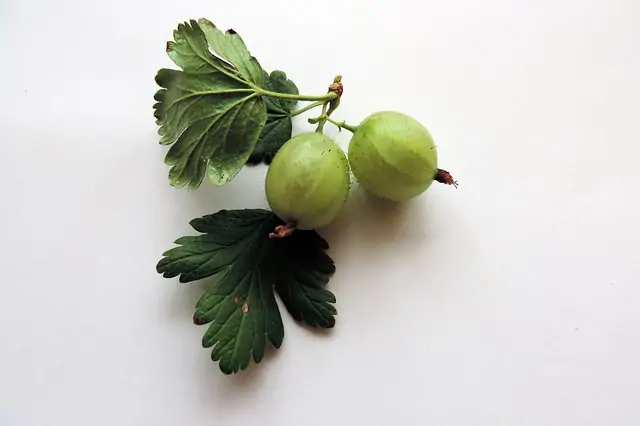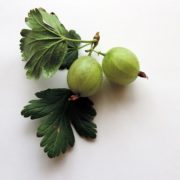Gooseberry Wine Recipe – Fantastic White Wine
Gooseberries may not be one of the cool kids in the world of berries. Often overlooked for strawberries, blackberries or blueberries in terms of eating but for winemaking the gooseberry is a king amongst berries. This gooseberry wine recipe will tame the tartness of these little green berries to make a fantastic wine.

A lot of people have a love/hate relationship with gooseberries. I think this is due to the fact they can be extremely tart. The most common culinary use for gooseberries is to add lots of sugar to act as a buffer against the tartness. In a wine, though the tartness can be welcome, many wine yeasts like Lalvin 71B-1122 metabolise the acid content in fruit and naturally mellow out the acid bite that gooseberries provide.
Acid is a key component in wine, that is why we add it to a lot of the fruit wine recipes you can see here on Home Brew Answers. Acidity in wine is important to balance the flavours, sweetness and acidity balance each other if present in the right quantities.
Most fruits with the exception of a few like wine grapes don’t have the required acidity to fully balance the wine and can leave the finished wine tasting thin, insipid and flabby. Fortunately, gooseberries, as we know, have a high acid content. This means no additional acid additions are required.
Table of Contents
Preparing Gooseberries For Wine Making
Only choose good fruit for your gooseberry wine, any fruit with bad spots or damage should be discarded. If you source your fruit from a pick your own farm or your own garden you will, of course, be sorting the gooseberries as you pick, you just need to wash the fruit.
Make sure all stems are removed, there are occasionally little brown tails on gooseberries which are fine to leave on.
Gooseberries are occasionally available in the supermarket but seem pretty rare to find, also there are some that grow wild and in hedgerows. These are usually cultivated varieties that have escaped into the wild which are fine to use as long as you are 100% certain you have correctly identified them.
There is also the question of colour, most varieties of gooseberry are green and will produce a white wine but there are pink and red varieties that will produce a slightly blush wine.
What You’ll Need To Make Gooseberry Wine – Makes 1 gallon / 4.5 litres
The equipment needed for this gooseberry wine recipe is fairly straightforward. You will need the following items, you can pick up any equipment you may need in our shop here.
- Fermenting Bucket
- Demijohn
- Large Pan
- Syphon
- Fine Straining Bag
- Potato Masher
- Airlock & Bung
Gooseberry Wine Ingredients
- 1.3kg Gooseberries
- 1.15kg of Sugar
- 4.2 litres of Water
- 0.5 tsp of Pectic Enzyme
- 1 tsp Yeast Nutrient
- 1 Campden Tablet
- 1 Sachet of Wine Yeast (Our recommendation is Lalvin EC-1118)
Gooseberry Wine Method
- In a pan heat 2 litres of water and add the sugar, bring to a boil for a few minutes then remove from the heat.
- Meanwhile, take the washed and prepared gooseberries and place them in the straining bag, put the straining bag in a sanitised fermenting bucket, and begin to crush all the berries to break them up.
- Pour the hot sugar solution over the gooseberries and mix thoroughly, add the remaining 2.2 litres of water which will bring the temperature down in the rest of the must, add the yeast nutrient, and 3-4 hours later when the must has cooled further add the Campden tablet and mix thoroughly
- 12 hours after adding the Campden tablet add the pectic enzyme which will aid juice and flavour extraction. Mix and leave for a further 24 hours.
- After 24 hours sprinkle the yeast on the surface of the must. Allow the wine to ferment for around a week and then lift out the bag with the remainder of the gooseberries. Allow fermentation to continue for a further week.
- After the two weeks rack the wine to a carboy, you can check the gravity at this point should you wish, fermentation should be pretty much complete at around 1.000 or lower. Once racked into a demijohn seal with a bung and airlock.
- You can wait for the gooseberry wine to completely clear before racking to a new vessel. Leave the wine for at least 4 months before bottling. If you wish to back-sweeten the wine stabilise and follow this advice here.




I have just started this recipe, the yeast has started chugging away nicely 🙂 i was wondering about tannins in the wine, would you add any at all or will it be fine without?
There is usually enough tannin in the skins of gooseberries. You can always sample the wine after fermentation and if you wish add tannin then if you think it is necessary.
I have just bottled this today, only had a couple months bulk aging, but it smelt so good that I couldn’t wait to taste it! It’s not bad on flavour, definitely like a white wine with the gooseberry tones. I’ve found it tastes somewhat earthy, would you say this is normal? Will time mellow this out?
I brewed 1 gallon each, green and red goosegogs. I fohnx that using 2.75 lbs meant a dry wine with less acidity. Having said that I found this page, searching for info about oak ageing. I have used sherry oak chips in the green goosegog wine, which seems to improve complexity.
Is it ok to use gooseberries that have been frozen?
Freezing is fine and it actually will break down the fruit extracting more juice so is beneficial for wine making.
Hiya, making my first wine as per the above recipe… should I have been stirring in fermentation or did you leave it for a week, when removing the gooseberries do I stir then to leave again for a week ready to syphon off please. Just worried about stirring as seems to be mixed advice on this. Thank you in advance 🙂
Some winemakers stir every day. This is practised by commercial wineries when the “punch down” the grape caps that form during early fermentation. The key thing is to make sure the gooseberries are not going to float and dry out on the surface of the must. If they are submerged you are extracting as much flavour and sugar as possible. You want to avoid introducing too much oxygen but because there is a lot of CO2 being produced during active fermentation it helps to prevent this.
thank you so much for your reply Neil, fruit removed… i will wait now until the weekend to syphon into the new bucket and but the airlock on.
I haven’t put the airlock on yet but lid closed hope this is right
Thank you
You can fit the airlock now. Once the lid is on I fit an airlock and it will stop any dust or flies out and let the CO2 escape.
hiya, Neil. Thank you so much for the help and guidance on this. Do you normally just use water in your airlock please?
ps I have now racked into a new bucket and checked and hydrometer read below 1 so so far so good 🙂
I have put the airlock on now but with water yet I am again reading mixed advice on what to put in the airlock.
The wine itself is looking fairly clear already so I will check for further settlement to rack again. But from the above you leave in the buckets for at least 4 months now before bottling.
Thank you again for all the answers its so hard when it’s your first time you want to just get it right 🙂
I use water in airlocks, I know some people use sanitiser or even vodka but I don’t feel it’s necessary.
It is good to age for a little while to improve the flavour try a sample to see if you are happy with it and, of course, rack if sediment builds up.
Hello I’m new to wine making but thought I’d give it a go as I have a grape vine. Unfortunately I didn’t have enough grapes this year (1ltr with skins) and I stumbled across this this recipe- luckily i have gooseberries (pink ones) as well. Not sure if it was the right thing to do but have added the gooseberries to the grapes – so I’ll see what happens 😬. I unfortunately missed the bit of the recipe where it said to put everything in a straining bag- will it be alright pour it through a straining bag into another bucket or will this add too much air? Thanks 😊
I am sure it will be fine and have done this before when I haven’t used a bag in the fermenter. A lot of winemakers prefer having loose fruit in the fermenter. All the best and hope the wine turns out well!
When sprinkling the yeast over, does this mean straight from the packet or should I add yeast to warm water first in a jug, then add?
Sprinkling from the sachet is fine. You can rehydrate yeast in water but it is not necessary for this particular recipe.
Hi, it’s my first batch using gooseberries nor I’am experienced wine maker. The process seemed to be going well; fermenting in the bucket, letting bubbles and smelling lovely gooseberries/ alkohol like. However, I moved it into dj after some days short of two weeks time and there is no any further fermentation going on. No bubbles in my airlock at all. Please advise what does that mean? Too soon in the dj? Many thanks!
This is perfectly normal. Once racked to the demijohn active fermentation will cease and the yeast will start cleaning up byproducts of fermentation and drop out of suspension. It sounds completely normal.
After the fruit has been in the bag for about a week,do I squeeze the juices from the bag when I remove it.?e